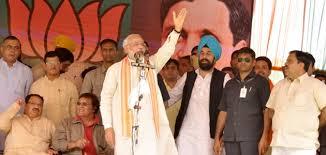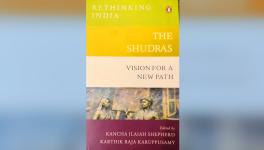Modifying the Idea of India
The BJP’s victory in this election is, clearly, a Modi victory. It is his brand of Hindutva that is now the dominant trend within the BJP; and Modi’s brand is a hard, divisive and fascistic one, as opposed to Vajpayee’s more consensual brand. Modi scored his victory within BJP first, sidelining all the older leaders, something which he had already done earlier in Gujarat. With the BJP now achieving a majority on its own, there is really no challenge to Modi within the NDA; there is no possibility of reining him in.
The Modi victory means the idea of India is at risk -- the secular republic we built out of the freedom movement. Modi represents the brand of Indian nationalism that was defeated during the freedom struggle – an Indian nationalism that rested on creating a Hindu identity as the basis of the Indian nation.

Image Courtesy: fr.wikipedia.org
Most commentators and observers have written about the failure of the Congress to rise to the Modi challenge. Rahul Gandhi has been held responsible for this failure since the Congress made him the central figure in the UPA campaign. The attempt of the neoliberal elite – who have been pushing a set of pro-rich and pro-foreign capital policies -- is to portray the failure of the Congress primarily as a failure of the dynasty. They claim Manmohan Singh was only a figurehead, somehow not responsible for the defeat of the Congress and its policies. Certainly Rahul failed to enthuse the voters as an alternative; but what doomed the Congress was precisely the set of policies that Manmohan spearheaded – economic liberalization and policies that took India toward the position of a subordinate ally of the US. Manmohan has been accused of giving into the 2G scam because of coalition politics. What then explains the coal scam when he was directly handling the coal ministry? Or the fact that Reliance was the recipient of government largesse on a massive scale?
Manmohan’s major fight in the UPA 1 was against the Left. The India-US nuclear deal was his “unique” legacy to the nation. As we now know, this deal has yielded nothing for India. It has only stifled its voice in the international arena. Whether it is IAEA (on the Iran issue), climate change or the WTO negotiations, India has played a dubious role, precisely because Manmohan Singh was unwilling to oppose the US. Perhaps the most servile of India’s reactions was when the Snowden revelations took place. While Dilma Roussef of Brazil and Angela Merkel of Germany protested to the US on their phones being tapped, India maintained an ignominious silence. And this was in spite of the tapping of the communications of the Indian delegation to G20 in London led by Manmohan Singh. Some people, from Swaminathan Aiyar to Sanjaya Baru, have tried to portray Manmohan as the victim of the dynasty. They seem to have forgotten that Manmohan ran the UPA for 10 years; it then becomes easier to forget that it is Manmohan’s policies that people are rejecting. It is Manmohan who believed in economic policies that would subsidise Indian capital with minerals, hydrocarbon, spectrum and land. This is what has created revulsion among voters.
Modi and his policies in Gujarat are only too well known. Moditva has a generous share of the two elements that have served as the bedrock of Hindutva ideology: an openly communal agenda coupled with pro-capitalist economics. The latter element is what has made the “Gujarat model” so attractive to big Indian capital. If Adani becomes even bigger, that does not bother Indian big capital – India is big enough for them to grow further. This confidence of big capital is what gave the Modi campaign its clout; it is what led to an unprecedented ad campaign, from the conventional media to the social media. We know that Gujarat is a state in which the benefits of development have gone only to a section of the elite, creating one of the most unequal societies in the country. But big capital has managed to create a mythical Gujarat in which development has trickled down to the people. This mythical Gujarat model, coupled with a communal campaign, backed by big media and big capital, has propelled Modi to power.
The other casualty in the election has been the Left. The second round of the elections witnessed massive booth capturing and rigging in Bengal. And this was concentrated in about 10% to 15% of booths in areas where the Left was strong. The TMC’s target was the Left, though the Congress too suffered in some constituencies. The Election Commission did nothing to stop this rigging, and it became more widespread in the third, fourth and fifth rounds of polling in Bengal. The media finally carried some of the visuals and reports of poll violence; but they did not bring to light the extent of such rigging and poll violence.
In the earlier Vajpayee era of the BJP, it was the Left that provided the ideological core around which the people could rally. The Congress as a party has always been hesitant to pit itself against hard-line Hindutva politics, preferring a soft Hindutva as its oppositional plank. As the Gujarat experience has shown, soft Hindutva does not work against hard Hindutva. The weakening of the Left at this juncture is a particularly hard blow to secular forces.
For all those who rallied round Mamta’s banner in Bengal, this should be an object lesson. Not only does she dabble in fascist politics – she came of age in the Hoodlum years of the 70’s in Bengal – but she is not averse to also aligning with the most retrogressive and fundamentalist elements among the Muslims. This has given a fillip to dormant Hindu communalism within the majority community in Bengal, held in check earlier by the ideological dominance of the Left. The Left will have to fight a difficult battle not only to rebuild its organisation under the threat of violence against its activists and supporters, but also against the communal poison being spread by Mamata’s policy of aligning with the Jamaat in Bengal and enabling the BJP’s communal agenda. Incidentally, the Jamaat in Bengal mobilised in a big way when the Jamaat leaders involved in the 1971 genocide in Bangaldesh were tried and convicted.
The Aam Aadmi Party believed that the impending demise of the dynasty and the Congress would help them emerge as the alternative. This has not happened. They tapped successfully into the deep anger of the people against drugs that are destroying the young in Punjab, a “business” in which the Akali and Congress leaders are implicated. Apart from this, AAP was restricted to some urban pockets. If AAP wants to become a genuine player in Indian politics, it needs to identify with greater clarity what exactly its politics consists of. Gimmicks and a negative platform – “We are against corruption!” – can only take it so far.
Meanwhile what do we, citizens who believe in a secular and pro-people idea of India, do? Only those who live in a fools’ paradise think Indian institutions are robust enough to withstand the toxic brand of politics that Modi represents. Our institutions will hold only if the people rally against the attacks on the idea of India that we built out of the freedom movement. And that is our task – a secular movement that will firmly oppose the Modification of our India. We have a hard battle ahead of us.
Disclaimer: The views expressed here are the author's personal views, and do not necessarily represent the views of Newsclick"
Get the latest reports & analysis with people's perspective on Protests, movements & deep analytical videos, discussions of the current affairs in your Telegram app. Subscribe to NewsClick's Telegram channel & get Real-Time updates on stories, as they get published on our website.























